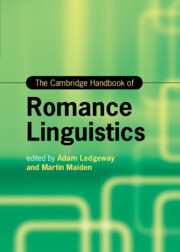Book contents
- The Cambridge Handbook of Romance Linguistics
- Cambridge Handbooks in Language and Linguistics
- The Cambridge Handbook of Romance Linguistics
- Copyright page
- Dedication
- Contents
- Figures
- Tables
- Contributors
- Abbreviations
- 1 Data, Theory, and Explanation: The View from Romance
- Part One What Is a Language?
- Part Two Phonetics and Phonology
- Part Three Morphology
- Part Four Syntax
- Part Five Semantics and Pragmatics
- 22 Word Meanings and Concepts
- 23 Key Topics in Semantics: Presupposition, Anaphora, (In)definite Nominal Phrases, Deixis, Tense and Aspect, Negation
- 24 Speech Acts, Discourse, and Clause Type
- 25 Address Systems and Social Markers
- 26 Information Structure
- Part Six Language, Society, and the Individual
- Index
- References
24 - Speech Acts, Discourse, and Clause Type
from Part Five - Semantics and Pragmatics
Published online by Cambridge University Press: 23 June 2022
- The Cambridge Handbook of Romance Linguistics
- Cambridge Handbooks in Language and Linguistics
- The Cambridge Handbook of Romance Linguistics
- Copyright page
- Dedication
- Contents
- Figures
- Tables
- Contributors
- Abbreviations
- 1 Data, Theory, and Explanation: The View from Romance
- Part One What Is a Language?
- Part Two Phonetics and Phonology
- Part Three Morphology
- Part Four Syntax
- Part Five Semantics and Pragmatics
- 22 Word Meanings and Concepts
- 23 Key Topics in Semantics: Presupposition, Anaphora, (In)definite Nominal Phrases, Deixis, Tense and Aspect, Negation
- 24 Speech Acts, Discourse, and Clause Type
- 25 Address Systems and Social Markers
- 26 Information Structure
- Part Six Language, Society, and the Individual
- Index
- References
Summary
This chapter considers how the Romance languages can contribute to our understanding of the encoding of discourse-oriented meaning, both structurally, at the level of the sentence, and, interpretatively, at the level of the utterance; more precisely, it focuses on the discourse-oriented meaning that interfaces between the wider extra-sentential discourse context on the one hand, and the propositional core of the utterance and the sentence-internal discourse context on the other. We present an overview of the contribution of Romance languages to a number of the key issues associated with theories of discourse at the level of the sentence/utterance, such as the grammatical expression of clause type, the codification of illocutionary force, and the mapping between form and function in the realization of speech acts, which are the communicative actions effected through the production of an utterance; in particular, we distinguish the morphosyntactic notion of clause type, meant as the formal or grammatical structure of a sentence codified through the lexicalization of dedicated functional slots within the left periphery of the clause, from that of illocutionary force, a pragmatic notion which refers to the communicative function attached to that expression.
Keywords
Information
- Type
- Chapter
- Information
- The Cambridge Handbook of Romance Linguistics , pp. 728 - 762Publisher: Cambridge University PressPrint publication year: 2022
References
Selected References
Accessibility standard: Unknown
Why this information is here
This section outlines the accessibility features of this content - including support for screen readers, full keyboard navigation and high-contrast display options. This may not be relevant for you.Accessibility Information
- 1
- Cited by
